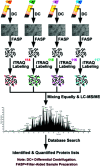Recent Developments and Applications of Quantitative Proteomics Strategies for High-Throughput Biomolecular Analyses in Cancer Research
- PMID: 34430874
- PMCID: PMC8341969
- DOI: 10.1039/d1cb00039j
Recent Developments and Applications of Quantitative Proteomics Strategies for High-Throughput Biomolecular Analyses in Cancer Research
Abstract
Innovations in medical technology and dedicated focus from the scientific community have inspired numerous treatment strategies for benign and invasive cancers. While these improvements often lend themselves to more positive prognoses and greater patient longevity, means for early detection and severity stratification have failed to keep pace. Detection and validation of cancer-specific biomarkers hinges on the ability to identify subtype-specific phenotypic and proteomic alterations and the systematic screening of diverse patient groups. For this reason, clinical and scientific research settings rely on high throughput and high sensitivity mass spectrometry methods to discover and quantify unique molecular perturbations in cancer patients. Discussed within is an overview of quantitative proteomics strategies and a summary of recent applications that enable revealing potential biomarkers and treatment targets in prostate, ovarian, breast, and pancreatic cancer in a high throughput manner.
Keywords: Quantitative proteomics; biomarker discovery; cancer research; isotopic labeling; mass spectrometry; systems biology.
Conflict of interest statement
CONFLICTS OF INTEREST There are no conflicts of interest to declare.
Figures








Similar articles
-
Mass spectrometry-based clinical proteomics: head-and-neck cancer biomarkers and drug-targets discovery.Mass Spectrom Rev. 2010 Nov-Dec;29(6):945-61. doi: 10.1002/mas.20296. Mass Spectrom Rev. 2010. PMID: 20945361 Review.
-
High-throughput proteomics of breast cancer subtypes: Biological characterization and multiple candidate biomarker panels to patients' stratification.J Proteomics. 2023 Aug 15;285:104955. doi: 10.1016/j.jprot.2023.104955. Epub 2023 Jun 28. J Proteomics. 2023. PMID: 37390896
-
Soluble polymer-based isotopic labeling (SoPIL): a new strategy to discover protein biomarkers?Expert Rev Proteomics. 2007 Oct;4(5):603-7. doi: 10.1586/14789450.4.5.603. Expert Rev Proteomics. 2007. PMID: 17941815
-
Translational Metabolomics of Head Injury: Exploring Dysfunctional Cerebral Metabolism with Ex Vivo NMR Spectroscopy-Based Metabolite Quantification.In: Kobeissy FH, editor. Brain Neurotrauma: Molecular, Neuropsychological, and Rehabilitation Aspects. Boca Raton (FL): CRC Press/Taylor & Francis; 2015. Chapter 25. In: Kobeissy FH, editor. Brain Neurotrauma: Molecular, Neuropsychological, and Rehabilitation Aspects. Boca Raton (FL): CRC Press/Taylor & Francis; 2015. Chapter 25. PMID: 26269925 Free Books & Documents. Review.
-
[Recent advances in glycopeptide enrichment and mass spectrometry data interpretation approaches for glycoproteomics analyses].Se Pu. 2021 Oct;39(10):1045-1054. doi: 10.3724/SP.J.1123.2021.06011. Se Pu. 2021. PMID: 34505426 Free PMC article. Review. Chinese.
Cited by
-
Green nanotechnology of MGF-AuNPs for immunomodulatory intervention in prostate cancer therapy.Sci Rep. 2021 Aug 18;11(1):16797. doi: 10.1038/s41598-021-96224-8. Sci Rep. 2021. PMID: 34408231 Free PMC article.
-
Quantitative Plasma Proteomics to Identify Candidate Biomarkers of Relapse in Pediatric/Adolescent Hodgkin Lymphoma.Int J Mol Sci. 2022 Aug 31;23(17):9911. doi: 10.3390/ijms23179911. Int J Mol Sci. 2022. PMID: 36077307 Free PMC article.
-
Statistical Testing for Protein Equivalence Identifies Core Functional Modules Conserved across 360 Cancer Cell Lines and Presents a General Approach to Investigating Biological Systems.J Proteome Res. 2024 Jun 7;23(6):2169-2185. doi: 10.1021/acs.jproteome.4c00131. Epub 2024 May 28. J Proteome Res. 2024. PMID: 38804581
-
Oncogenic Proteomics Approaches for Translational Research and HIV-Associated Malignancy Mechanisms.Proteomes. 2023 Jul 4;11(3):22. doi: 10.3390/proteomes11030022. Proteomes. 2023. PMID: 37489388 Free PMC article. Review.
References
-
- Aksenov A. A. da Silva R. Knight R. Lopes N. P. Dorrestein P. C. Global chemical analysis of biology by mass spectrometry. Nat. Rev. Chem. 2017;1(7):0054.
-
- Paglia G. Astarita G. Metabolomics and lipidomics using traveling-wave ion mobility mass spectrometry. Nat. Protoc. 2017;12(4):797–813. - PubMed
Grants and funding
LinkOut - more resources
Full Text Sources

